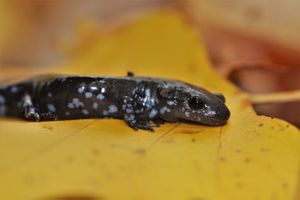Blue-spotted salamander: Difference between revisions
No edit summary |
No edit summary |
||
| Line 9: | Line 9: | ||
Their distribution range spreads from the north of the New England area to as far west as Wisconsin and Minnesota. These salamanders live in both deciduous and coniferous forests with moist woodlands. The presence of vernal pools that retain water into the mid-summer is essential for their habitat. One would most likely find them underneath the leaf litter and logs. During the warmer months they may even move about in the open during rain showers. | Their distribution range spreads from the north of the New England area to as far west as Wisconsin and Minnesota. These salamanders are cold tolerant and live in both deciduous and coniferous forests with moist woodlands. The presence of vernal pools that retain water into the mid-summer is essential for their habitat. One would most likely find them underneath the leaf litter and logs. During the warmer months they may even move about in the open during rain showers. | ||
Similar to many amphibian species, their habitat is being threatened by human development. Commercial, residential, and industrial construction all have negative impacts upon their populations and habitat. Blue-spotted | Similar to many amphibian species, their habitat is being threatened by human development. Commercial, residential, and industrial construction all have negative impacts upon their populations and habitat. Blue-spotted Salamanders are listed as "Least Concern" by the IUCN Red List. | ||
== Ecology == | == Ecology == | ||
Revision as of 13:58, 8 April 2021
Physical Description

The Blue-spotted Salamander is black with blue spots and specks all over the body, sides, arms, and tail. They have 12-14 costal grooves. Adults grow to be 3-5 inches ( 7.6-14 cm), females are slightly larger.
Habitat
Their distribution range spreads from the north of the New England area to as far west as Wisconsin and Minnesota. These salamanders are cold tolerant and live in both deciduous and coniferous forests with moist woodlands. The presence of vernal pools that retain water into the mid-summer is essential for their habitat. One would most likely find them underneath the leaf litter and logs. During the warmer months they may even move about in the open during rain showers.
Similar to many amphibian species, their habitat is being threatened by human development. Commercial, residential, and industrial construction all have negative impacts upon their populations and habitat. Blue-spotted Salamanders are listed as "Least Concern" by the IUCN Red List.
Ecology
Their diet consists of mostly small invertebrates such as snails, earthworms, centipedes, and spiders. When the salamanders are in the breeding pools they can also eat aquatic invertebrates like water fleas and copepods. They prefer to spend most of their time hidden in darkness under logs and fallen leaves. When darkness or rain comes they will venture out in the open. If danger presents itself these salamanders are capable of
Reproduction
References
[1] Harding, J. & Mifsud, D. "Amphibians & Reptiles of the Great Lakes Region". University of Michigan Press, 2017. pg 58-62
[2] "Ambystoma laterale" IUCN Red List of Threatended Species. 2004.
[3] Blue-spotted salamander photographed at Letchworth Woods, University at Buffalo on 25th October 20202 by Nikolai Harper